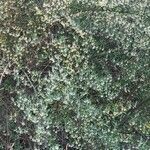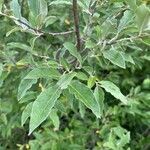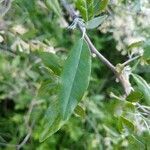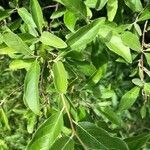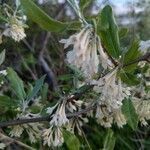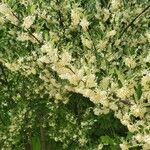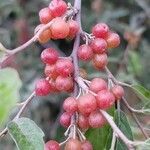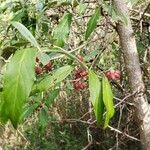Shrubs, deciduous, erect with branchlets spreading. New branches and buds silvery scaly. Petiole 3-5(-10) mm; leaf blade obovate, 2.2-5.5(-8) × 1-1.6(-2.5) cm, papery, abaxially densely white scaly, adaxially sparsely scaly when young, lateral veins 5-8 per side of midrib, base cuneate, apex acute to obtuse. Flowers 1-3(-7)-fasciculate in axils of both long and short shoots; pedicel 3-6(-8) mm, to 1.2 cm in fruit. Flowers silvery white. Calyx tube funnel-shaped, 5-7 mm, slender; lobes triangular-ovate, 2.8-3 mm. Filaments ca. 0.7 mm; anthers elliptic, 1.8-2 mm. Style 6-7 mm, with stellate hairs; stigma ca. 2.2 mm. Drupe red, nearly globose, (6-)8-9 mm. Seed ca. 7 mm. Fl. Apr-May, fr. Jul-Aug. 2n = 28*.
A shrub. It grows 3-9 m high and 9 m wide. The new shoots are golden brown and thorny. The leaves are soft green and have wavy edges. They are silvery underneath. The flowers are yellow-white and fragrant. The fruit are small orange to red berries. One shrub can produce 54,000 seeds in a year.
Shrubby tree to 5 m; lvs soon green and glabrescent above; hypanthium-tube ca twice as long as the sep; fr red, finely dotted with pale scales, juicy and edible, 6–8 mm, on pedicels ca 1 cm; 2n=28. Native of e. Asia, becoming common in much of our range. May, June.
